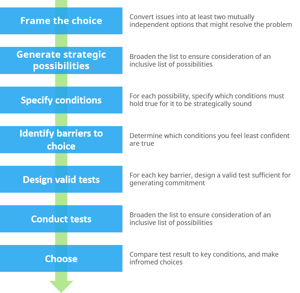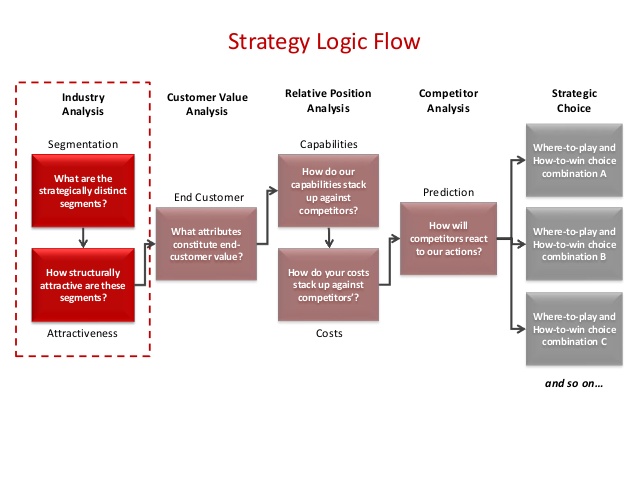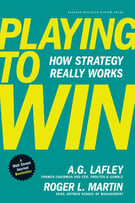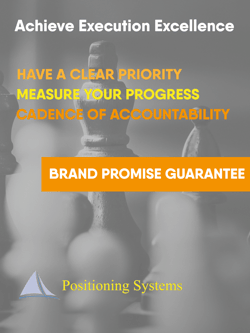 A good friend of mine and I met for coffee early Thursday morning.
A good friend of mine and I met for coffee early Thursday morning.
His company’s profits were 5X less this in 2019 than the previous year. Several of their competitors copied their designs significantly gashing their revenues.
None of us can make decisions in a vacuum.
Do your strategy decisions include understanding and anticipating what your competitor will do to combat your decisions?
Had my friends company considered competitors would copy their design, would they have been able to provide a more competitive and innovative design to stay ahead of them?
If your business is growing, exceeding $10 Million in Revenue, you need to consider what your competitors are doing, and how they will respond to your strategy decisions.
What Will Your Competitor Do? - Example
.jpg?width=150&name=Joy%20Dish%20Soap%20(P%26G).jpg) In Playing to Win, A.G. Lafley provides an example of how competitive reaction played a crucial role in P&G’s decision to launch a new dish detergent in Japan in the 1990's.
In Playing to Win, A.G. Lafley provides an example of how competitive reaction played a crucial role in P&G’s decision to launch a new dish detergent in Japan in the 1990's.
At the time, Japan was dominated by two massive players: Kao and Lion. Both sold dish soap in large bottled containers. The soap was diluted with lots of water. The products had little differentiation, other than name and fragrance. P&G saw an opportunity to launch Joy, using the proprietary grease-fighting technology from P&G’s successful US Dawn brand. Highly concentrated, Joy sold in a bottle one-quarter the size of competitive offerings.
The P&G team believed it could get retailers excited about selling more bottles with less shelf space and a healthy price premium. Joy seemed a good fit with consumer values due to its better grease-fighting technology. (See TV Ad)
How would the competitors react?
The team determined if the competitors stayed with their existing diluted format, Joy could win handily. If the competitors launched a concentrated version, but continued to produce diluted as well, Joy would still win. Kao and Lion would face considerably higher costs and split their product focus.
The only real danger was if the competitors dropped their diluted versions and threw everything behind new, concentrated detergents. Joy would stand little chance against established local competitors.
Kao and Lion were large, traditional firms with a great deal invested in their current approach. Most of their category profit came from these diluted formulas.
The team believed at worst, the competitors would move to produce both dilute and concentrate.
RESULT: The competitors chose to defend their existing dilute product lines and launched a concentrated version. Joy created a sizable new segment, taking most of it. By 1997, Joy captured 30 percent of the total dish detergent market and was the number one dish brand in Japan. (See P&G's Joy Makes a Splash In Japan's Dish Soap Market)
A Framework for Strategy
To make good choices, you need to make sense of the complexity of your environment. The strategy logic flow points you to the key areas of analysis necessary to generate sustainable competitive advantage.
The Strategy Logic Flow provides a road map to follow.
 Look to understand the industry you play in (or will play). What are the distinct segments and relative attractiveness? Don’t assume your map of the world is the only possible map.
Look to understand the industry you play in (or will play). What are the distinct segments and relative attractiveness? Don’t assume your map of the world is the only possible map.
Next, turn to customers. What do either channel and end consumers truly want, need, and value? How do these needs fit with your current or potential offerings? You’ll need to dig deep. Engage in joint value creation with channel partners and seek a new understanding of your end consumers.
Then turn your lens inward: what are your capabilities and costs relative to the competition? The Key Question: Can you be a differentiator or a cost leader?
Finally, consider competition; what will your competitors do in the face of your actions?
Throughout the Strategy process, be sure to be open to recast your previous analysis. Consider what you learn in each subsequent box. The basic direction of the process is from left to right. There are interdependencies.
Working through the framework takes both patience and imagination. It also takes teamwork.
 From Playing to Win, “Any new strategy is created in a social context—it isn’t devised by an individual sitting alone in an office, thinking his or her way through a complex situation. Rather, strategy requires a diverse team with the various members bringing their distinct perspectives to bear on the problem. A process for working collaboratively on strategy is essential, because all companies are social entities, made up of a diverse network of individuals with different agendas and ideas. Those people need to think, communicate, decide, and act together, in order to accomplish anything meaningful.”
From Playing to Win, “Any new strategy is created in a social context—it isn’t devised by an individual sitting alone in an office, thinking his or her way through a complex situation. Rather, strategy requires a diverse team with the various members bringing their distinct perspectives to bear on the problem. A process for working collaboratively on strategy is essential, because all companies are social entities, made up of a diverse network of individuals with different agendas and ideas. Those people need to think, communicate, decide, and act together, in order to accomplish anything meaningful.”
Growth demands Strategic Discipline.
 To build an enduring great organization, requires disciplined people, disciplined thought, disciplined action, to produce superior results, and make a distinctive impact in the world.
To build an enduring great organization, requires disciplined people, disciplined thought, disciplined action, to produce superior results, and make a distinctive impact in the world.
Discipline sustains momentum, over a long period of time, laying the foundations for lasting endurance.
A winning habit starts with 3 Strategic Disciplines: Priority, Metrics and Meeting Rhythms. Forecasting, accountability, individual, and team performance improve dramatically.
Meeting Rhythms achieve a disciplined focus on performance metrics to drive growth.
Let Positioning Systems help your business achieve these outcomes on the Four most Important Decisions your business faces:
|
DECISION |
RESULT/OUTCOME |
|
PEOPLE |
|
|
STRATEGY |
|
|
EXECUTION |
|
|
CASH |
|
Positioning Systems helps mid-sized ($5M - $250M) business Scale-UP. We align your business to focus on Your One Thing! Contact dwick@positioningsystems.com to Scale Up your business! Take our Four Decisions Needs Assessment to discover how your business measures against other Scaled Up companies. We’ll contact you.
 NEXT BLOG – Accountability: Job Descriptions
NEXT BLOG – Accountability: Job Descriptions
Two of my customers are focused on job descriptions for 2020. At our quarterly meeting Friday, one leadership member offered since identifying his accountabilities he’s felt more clarity and a sense of freedom about his work. Without job descriptions such as a Job Summary Scorecard, your people don’t know what’s expected of them. Worse for the company, you’re not achieving results. Next Blog how to achieve Accountability in Job Descriptions.






.jpeg?width=150&height=135&name=Hand%20with%20marker%20writing%20the%20question%20Whats%20Next_%20(1).jpeg)

